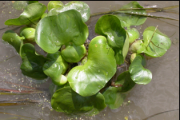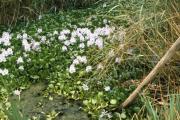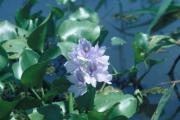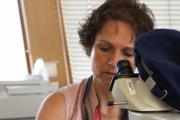Austrian biologist Brigitte Schmidt has had good luck in discovering some new recent finds during the survey. The first is the water hyacinth
(Eichhornia crassipes), a floating water plant with inflated spongy leaf stems and a beautiful lavender flower-spike, found in Hungary near Szentendre Island at Sampling Site 28. Many plant enthusiasts love to buy it for their little outdoor pond gardens or in-house aquariums. It grows in temperate climates all over the world, often forming dense "river rafts" in the summer that cause significant problems for boat navigation. The water hyacinth is a vigorous grower known to double its population in two weeks. In Europe, it is known to be wild only in Portugal. Not adapted to cold winters, Schmidt is convinced that the hyacinth will not be able to survive the cold continental climate typical for this part of the Danube. At the same time, it is also not a great idea to have such exotic individuals in the Danube environment at all, as they pose a threat to local species.
At Sampling Site 45 at Ilok, Croatia, Brigitte identified Azolla for the first time in the Danube River. While Azolla looks like moss, it is actually a genus of seven species of aquatic ferns. Also known as mosquito fern, duckweed fern, fairy moss and water fern, it floats on the water surface by means of many small, closely-overlapping scale-like leaves, with its roots hanging in the water. They also form a symbiotic relationship with cyanobacterium Anabaena azollae, which allows the plants to fix nitrogen from the air. Azolla has been known to grow so fast that it can double its mass in three days. They are also a favourite of water-garden hobbyists.



















